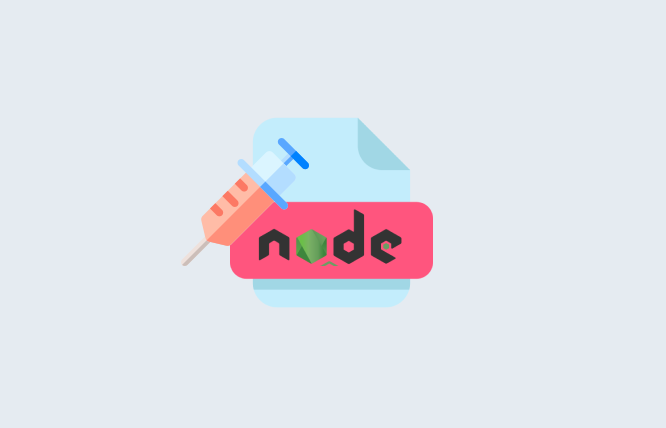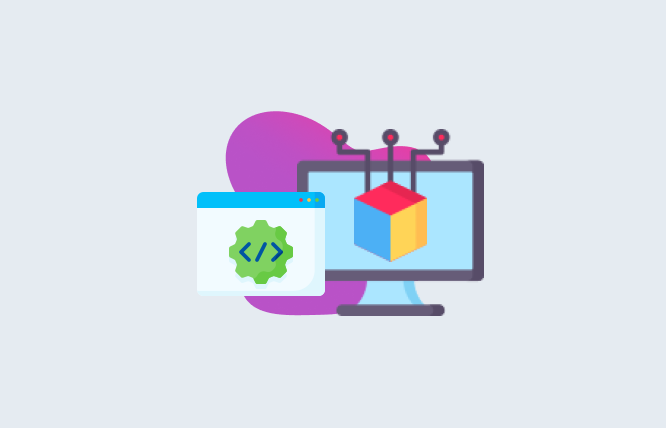We are going to talk about NodeJS Dependency Injection, elucidating its role in fostering cleaner code. It explains the significance of clean code and how DI facilitates modular, testable, and maintainable NodeJS applications. Covering basic implementation strategies, best practices, and real-world applications, it also provides knowledge to streamline development processes and enhance scalability in their projects.
NodeJS Dependency Injection is a method or design pattern in software development used to manage and organise the components of a NodeJS application by providing the necessary dependencies to different parts. Dependency injection in JS facilitates modularity, flexibility, and easier testing.
In NodeJS, applications rely heavily on different modules and small pieces of code to perform specific tasks. That’s where Dependency injection takes the lead and allows these modules to communicate and work together seamlessly.
What Does “Clean Code” Mean?
Clean code refers to simple codes that are easy to read, understand, and maintain. The purpose of clean code is to provide clarity and efficiency, making the codebase more manageable and less prone to errors.
Why is NodeJS Dependency Injection Important?
NodeJS development no longer goes around traditional approaches, where objects directly create their own dependencies, leading to tight coupling. This means changes to one object ripple through connected objects, making maintenance and testing challenging.
Dependency injection NodeJs flips the script. Instead of objects creating their own dependencies, they receive them through injection, usually via constructors or setter methods. The result? It enables object decoupling, promoting modularity, testability, and maintainability.
Here’s what Dependency Injection in JS can offer:
- Modularity – To break down complex applications into smaller, self-contained modules, making them easier to understand, manage, and reuse.
- Testability – To isolate and test individual components with mocked dependencies, ensuring each component of your code functions as expected.
- Maintainability – To adapt to changes without affecting unrelated parts of your code.
Dependency Injection in NodeJS: All You Need to Know
Dependency injection simplifies the management of dependencies within applications. With decoupling components and external dependencies, developers can achieve greater flexibility and reusability in their code.
Implementing dependency injection in NodeJS involves structuring the application in a way that separates concerns and promotes modular design. This allows for easier maintenance and testing, as individual components can be isolated and replaced without affecting the entire system.
There are two main approaches and technical aspects of NodeJS:
Manual Injection
You directly pass dependencies to objects through their constructors or setter methods. This offers control but requires more boilerplate code.
Dependency Injection Frameworks
Frameworks like InversifyJS automate the dependency management process and simplify setup and configuration. You get additional features like dependency resolution and lifecycle management, not to mention the additional complexity.
The scope and complexities of your project will dictate the best strategy to use. However, it may be adequate to use manual injection for smaller tasks. A DI framework may simplify development and provide consistency for bigger applications. But to get an expert opinion, consult with Nodejs, a technology solution services provider. FuturByte is a prominent name with a team of industry-leading professionals who specialise in the latest web development stacks.
How to Implement NodeJS Dependency Injection
Let’s get hands-on and explore how to implement Dependency Injection in your projects. We’ll cover both manual and framework-based approaches, equipping you to choose the right method for your needs.
Manual Dependency Injection
Manual DI is like sorting and handing components directly to the desired place. Here’s how it works:
Define Interfaces:
Start by defining interfaces for your dependencies. These act as blueprints, specifying the methods and properties a dependency must have.
Inject Dependencies:
Pass dependencies through object constructors or setter methods. For example:
Here, the UserRepository receives the database dependency through its constructor.
Mock Dependencies for Testing:
During testing, replace real dependencies with mocks that simulate their behaviour. As a result, you may separate and test each component separately.
| Pros | Cons |
Dependency Injection Frameworks
DI frameworks like InversifyJS offer similar automation, simplifying dependency management.
Install and Configure:
Choose a framework and follow its setup instructions. InversifyJS requires defining bindings between interfaces and their concrete implementations.
Inject Using Decorators or Bindings:
Frameworks often use decorators or configuration files to specify how dependencies are injected.
Enjoy the Benefits:
Frameworks handle dependency resolution and lifecycle management, freeing you to focus on core logic.
| Pros | Cons |
Choosing the Right Approach
The best approach depends on your project’s size and complexity. For small projects, manual DI might suffice. For larger projects, a framework can save time and effort.
Next Steps
- Explore popular DI frameworks like InversifyJS or TypeORM.
- Find tutorials and examples to practice implementing DI in your projects.
- Start small and gradually integrate DI into your existing codebase.
By following these steps and choosing the right approach, you can leverage DI to build cleaner, more maintainable, and ultimately more enjoyable NodeJS applications! However, talk to an expert or mean stack development company for NodeJS Dependency Injection for Cleaner Code.
Best Practices for Dependency Injection in NodeJS Applications
Node JS development services provider must implement dependency injection in NodeJS applications to ensure optimal performance and maintainability. Some best practices include:
- Keep dependencies explicit
Clearly define and declare dependencies to promote transparency and facilitate code maintenance.
- Use dependency injection containers sparingly
While dependency injection containers can streamline dependency management, avoid overusing them, as they can introduce unnecessary complexity.
- Favour constructor injection
Prefer constructor injection over setter injection, as it promotes immutability and ensures that dependencies are available when an object is created.
Streamlining Development with NodeJS Dependency Injection
DI in NodeJS fosters modular, testable, and maintainable code, qualities crucial for scaling development and tackling complex projects.
Let’s recap the key advantages.
- Break down monolithic applications into smaller, self-contained modules.
- Isolate and test individual components with mocked dependencies, ensuring each brick functions as expected.
- When requirements change, you’re not stuck reconstructing the entire castle. With loosely coupled components, modifications to one part have less impact on others.
These advantages translate into real-world benefits for your development workflow.
- Focus on core functionality without getting bogged down in managing dependencies.
- Efficiently test and debug individual components, ensuring code quality and reducing overall development time.
- Adapt to changing requirements and fix bugs with ease.
But wait, there’s more! Dependency Injection can also open doors to exciting possibilities:
Consider using Dependency Injection to build microservices architectures where different languages, like PHP web development or dot net development, handle specific functionalities. Each microservice could leverage DI internally, allowing seamless interaction within your overall system.
Moreover, it offers code readability and maintainability, making it easier for everyone to understand and contribute to the project, regardless of their expertise in LAMP development services or their background as an Angular Developer.
Conclusion
NodeJS Dependency Injection is a powerful tool for building cleaner, modular, and maintainable NodeJS applications. It simplifies development workflows, promotes code organisation, and enables seamless integration of services. It also improves code quality and accelerates time-to-market.
Frequently Asked Questions
DI offers several advantages: Faster development: Focus on core functionality without managing dependencies.Improved testability: Isolate and test individual components with ease.Enhanced maintainability: Adapt to changes and fix bugs effortlessly.
Dependency Injection is ideal for projects of all sizes, especially those with complex logic, multiple dependencies, or potential for future growth. It promotes modularity and testability, making your code more sustainable in the long run.
You can choose manual Dependency Injection, where you manage dependencies directly, or use DI frameworks like InversifyJS or TypeORM for automated dependency management and advanced features.
While Dependency Injection doesn’t directly enable integration with PHP web development services or Dot Net development, it promotes modular code that can be used in conjunction with other technologies. Microservices architectures and API gateways can leverage DI principles for smoother interaction between different languages.
Explore these resources:In-depth tutorials on NodeJS DIPopular DI frameworks like InversifyJS and TypeORMCase studies showcasing real-world DI implementations
No, dependency injection (DI) is not inherently part of MEAN or MERN stacks. These stacks define specific sets of technologies used for web development:MEAN: MongoDB, ExpressJS, AngularJS (now Angular), and NodeJS.MERN: MongoDB, ExpressJS, ReactJS, and NodeJS.Neither stack explicitly dictates the use of DI as a design pattern. However, DI can be effectively implemented within both MEAN and MERN stacks to improve their code quality and maintainability.
While DI isn’t inherently part of MEAN or MERN stacks, you can effectively implement it to enhance your projects. Here are some approaches: Manual DIPass dependencies directly to the constructor or setter methods of your components. DI FrameworksConsider frameworks like InversifyJS or TypeORM that automate dependency management. Angular Dependency InjectionIf using Angular (MERN), leverage its built-in dependency injection mechanism.Inject dependencies through its @Injectable decorator and constructor parameters. ExpressJS MiddlewareCreate custom middleware in ExpressJS (MEAN/MERN) to inject dependencies into routes. Third-Party LibrariesExplore libraries like NestJS (built on ExpressJS) that provide DI features alongside other functionalities.
DI offers several advantages: Faster development: Focus on core functionality without managing dependencies.Improved testability: Isolate and test individual components with ease.Enhanced maintainability: Adapt to changes and fix bugs effortlessly.
Dependency Injection is ideal for projects of all sizes, especially those with complex logic, multiple dependencies, or potential for future growth. It promotes modularity and testability, making your code more sustainable in the long run.
You can choose manual Dependency Injection, where you manage dependencies directly, or use DI frameworks like InversifyJS or TypeORM for automated dependency management and advanced features.
While Dependency Injection doesn’t directly enable integration with PHP web development services or Dot Net development, it promotes modular code that can be used in conjunction with other technologies. Microservices architectures and API gateways can leverage DI principles for smoother interaction between different languages.
Explore these resources:In-depth tutorials on NodeJS DIPopular DI frameworks like InversifyJS and TypeORMCase studies showcasing real-world DI implementations
No, dependency injection (DI) is not inherently part of MEAN or MERN stacks. These stacks define specific sets of technologies used for web development:MEAN: MongoDB, ExpressJS, AngularJS (now Angular), and NodeJS.MERN: MongoDB, ExpressJS, ReactJS, and NodeJS.Neither stack explicitly dictates the use of DI as a design pattern. However, DI can be effectively implemented within both MEAN and MERN stacks to improve their code quality and maintainability.
While DI isn’t inherently part of MEAN or MERN stacks, you can effectively implement it to enhance your projects. Here are some approaches: Manual DIPass dependencies directly to the constructor or setter methods of your components. DI FrameworksConsider frameworks like InversifyJS or TypeORM that automate dependency management. Angular Dependency InjectionIf using Angular (MERN), leverage its built-in dependency injection mechanism.Inject dependencies through its @Injectable decorator and constructor parameters. ExpressJS MiddlewareCreate custom middleware in ExpressJS (MEAN/MERN) to inject dependencies into routes. Third-Party LibrariesExplore libraries like NestJS (built on ExpressJS) that provide DI features alongside other functionalities.
Have questions or feedback?
Get in touch with us and we‘l get back to you and help as soon as we can!




